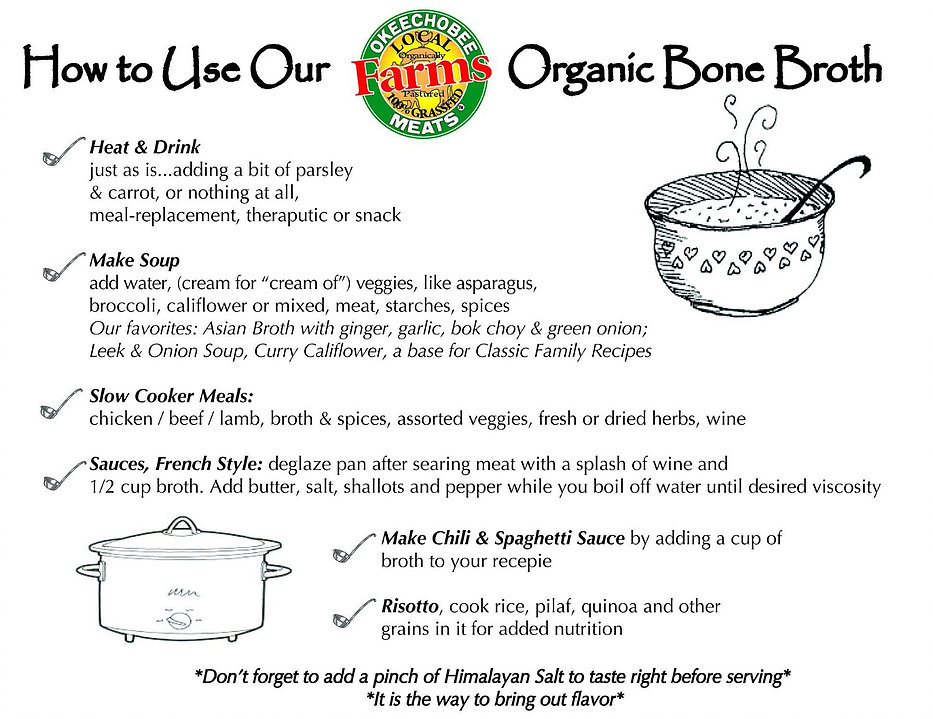Bone Broth
The Healing Goodness of Broth and How to use it
Bone Broth, Broths and Stocks
Bone broths are given special emphasis among traditional foods circles. And many societies across the globe have historically placed special emphasis on the preparation of the whole animal, including the use of bones for making”nutraceutical broth. In Asia, emphasis is placed on stocks and broths made from fish and fish bones, as well as beef bones for popular soups like Korean bone soup. In Europe, stocks and broths have become the foundation of cooking and are used in not only making soups and stews, but also for preparing reductions, sauces and for braising vegetables and meats.
The Difference Between Broth, Stock and Bone Broth
In traditional foods circles you’ll hear a lot about broth, stock and bone broth – and they’re typically used interchangeably. Bone broth, broth and stock are built on the same basic foundation: water, meat or bones (or both), vegetables and seasonings. As it cooks, the liquid is typically skimmed (although this is not necessary since the foam that rises to the top of the stock pot – off-putting as it is – is rich in protein) and eventually the solids are removed by straining the stock with a fine-mesh sieve or reusable coffee filter.
Broth is typically made with meat and can contain a small amount of bones (think of the bones in a fresh whole chicken). Broth is typically simmered for a short period of time (45 minutes to 2 hours). It is very light in flavor, thin in texture and rich in protein.
Stock is typically made with bones and can contain a small amount of meat (think of the meat that adheres to a beef neck bone). Often the bones are roasted before simmering them as this simple technique greatly improves the flavor. Beef stocks, for example, can present a faint acrid flavor if the bones aren’t first roasted. Stock is typically simmered for a moderate amount of time (3 to 4 hours). Stock is a good source of gelatin.
Bone Broth is typically made with bones and can contain a small amount of meat adhering to the bones. As with stock, bones are typically roasted first to improve the flavor of the bone broth. Bone broths are typically simmered for a very long period of time (often in excess of 24 hours), with the purpose being not only to produce gelatin from collagen-rich joints but also to release minerals from bones. At the end of cooking, the bones should crumble when pressed lightly between your thumb and forefinger.
Why Bone Broths are Good for You
Bone broths are extraordinarily rich in protein, and can be a source of minerals as well. Glycine supports the bodies detoxification process and is used in the synthesis of hemoglobin, bile salts and other naturally-occurring chemicals within the body. Glycine also supports digestion and the secretion of gastric acids. Proline, especially when paired with vitamin C, supports good skin health. Bone broths are also rich in gelatin which may support skin health. Gelatin also support digestive health which is why it plays a critical role in the GAPS diet. And, lastly, if you’ve ever wondering why chicken soup is good for a cold, there’s science behind that, too. Chicken broth inhibits neutrophil migration; that is, it helps mitigate the side effects of colds, flus and upper respiratory infections.
How to Store Bone Broth
Bone broth can be stored in the refrigerator for no more than a week. You can also freeze it in ice cube trays, and transfer the frozen cubes of broth to a resealable freezer bag where they will keep for 6 months. Alternatively, consider making Homemade Bouillon. Read more information about various methods for storing broth here including reduction, freezing and making powdered broth.


